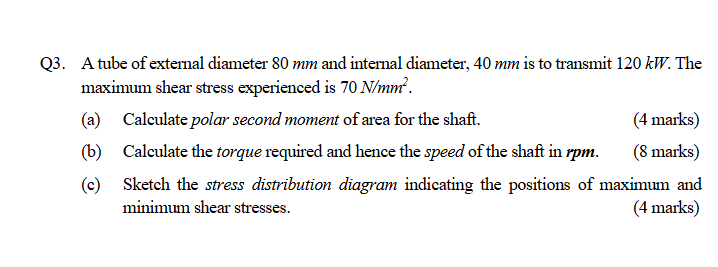A tube of external diameter 80 mm and internal diameter 40 mm is to transmit 120 kW. The maximum shear stress experienced is 70 N/mm². (a) Calculate polar second moment of area for... A tube of external diameter 80 mm and internal diameter 40 mm is to transmit 120 kW. The maximum shear stress experienced is 70 N/mm². (a) Calculate polar second moment of area for the shaft. (b) Calculate the torque required and hence the speed of the shaft in rpm. (c) Sketch the stress distribution diagram indicating the positions of maximum and minimum shear stresses.

Understand the Problem
The question presents a scenario involving a tube transmitting power and experiencing shear stress. It requires calculating the polar second moment of area, the torque and speed of the shaft, and sketching the stress distribution diagram. It is a typical homework question for mechanical engineering students.
Answer
(a) $J = 376991.12 \, \text{mm}^4$ (b) $T = 659.73 \, \text{Nm}$, $N = 1737.15 \, \text{rpm}$ (c) Linear shear stress distribution, minimum at inner radius, maximum at outer radius.
Answer for screen readers
(a) The polar second moment of area is $376991.12 , \text{mm}^4$.
(b) The torque required is $659.73 , \text{Nm}$ and the speed of the shaft is $1737.15 , \text{rpm}$.
(c) The shear stress distribution diagram should show a linear increase in stress, from a minimum value at the inner radius (40mm) to the maximum value (70 N/mm²) at the outer radius (80mm). The stress at the inner radius will be half of the stress at the outer radius, as the radius is half.
Steps to Solve
- Calculate the polar second moment of area $J$
The polar second moment of area ($J$) for a hollow circular shaft is given by: $J = \frac{\pi}{32}(D^4 - d^4)$, where $D$ is the external diameter and $d$ is the internal diameter. Given $D = 80 \text{ mm}$ and $d = 40 \text{ mm}$, substitute these values into the formula: $$ J = \frac{\pi}{32}(80^4 - 40^4) $$
$$ J = \frac{\pi}{32}(40960000 - 2560000) $$
$$ J = \frac{\pi}{32}(38400000) $$
$$ J = 376991.1184 \text{ mm}^4 $$
- Calculate the torque $T$
We can use the torsion formula to find the torque $T$: $\frac{T}{J} = \frac{\tau}{r}$, where $\tau$ is the maximum shear stress, $r$ is the outer radius, and $J$ is the polar second moment of area.
Given $\tau = 70 \text{ N/mm}^2$ and $r = \frac{D}{2} = \frac{80}{2} = 40 \text{ mm}$, we can rearrange the formula to solve for $T$:
$$ T = \frac{\tau \cdot J}{r} $$
$$ T = \frac{70 \cdot 376991.1184}{40} $$
$$ T = 659734.4572 \text{ Nmm} $$
Convert $T$ to Nm:
$$ T = 659.73 \text{ Nm} $$
- Calculate the speed $N$ (in rpm)
The power $P$ is related to the torque $T$ and speed $N$ by the formula: $P = \frac{2\pi N T}{60}$, where $P$ is in Watts, $T$ is in Nm, and $N$ is in rpm. Given $P = 120 \text{ kW} = 120000 \text{ W}$, we can rearrange the formula to solve for $N$:
$$ N = \frac{60P}{2\pi T} $$
$$ N = \frac{60 \cdot 120000}{2\pi \cdot 659.73} $$
$$ N = \frac{7200000}{4144.82} $$
$$ N = 1737.15 \text{ rpm} $$
- Sketch the stress distribution diagram
The stress distribution in a hollow circular shaft varies linearly from the inner radius to the outer radius. The shear stress is zero at the center, minimum at the inner radius, and maximum at the outer radius. The diagram should show a linear increase in stress from the inner surface to the outer surface.
(a) The polar second moment of area is $376991.12 , \text{mm}^4$.
(b) The torque required is $659.73 , \text{Nm}$ and the speed of the shaft is $1737.15 , \text{rpm}$.
(c) The shear stress distribution diagram should show a linear increase in stress, from a minimum value at the inner radius (40mm) to the maximum value (70 N/mm²) at the outer radius (80mm). The stress at the inner radius will be half of the stress at the outer radius, as the radius is half.
More Information
The polar second moment of area represents a shaft's resistance to torsional deformation. The stress distribution is linear for a hollow shaft under torsion, meaning the shear stress increases proportionally with the radius, from the inner to the outer surface.
Tips
A common mistake is to use the diameter instead of the radius in the stress calculations or to forget to convert units (e.g., kW to W, mm to m) leading to errors in the final answer.
AI-generated content may contain errors. Please verify critical information